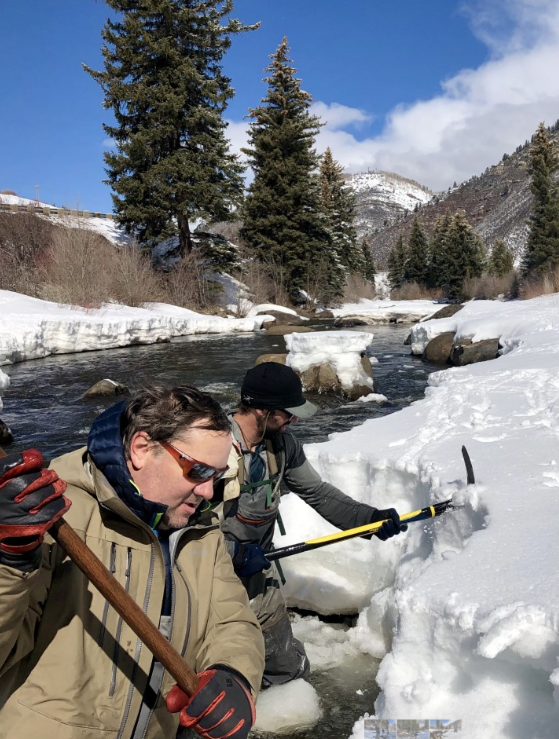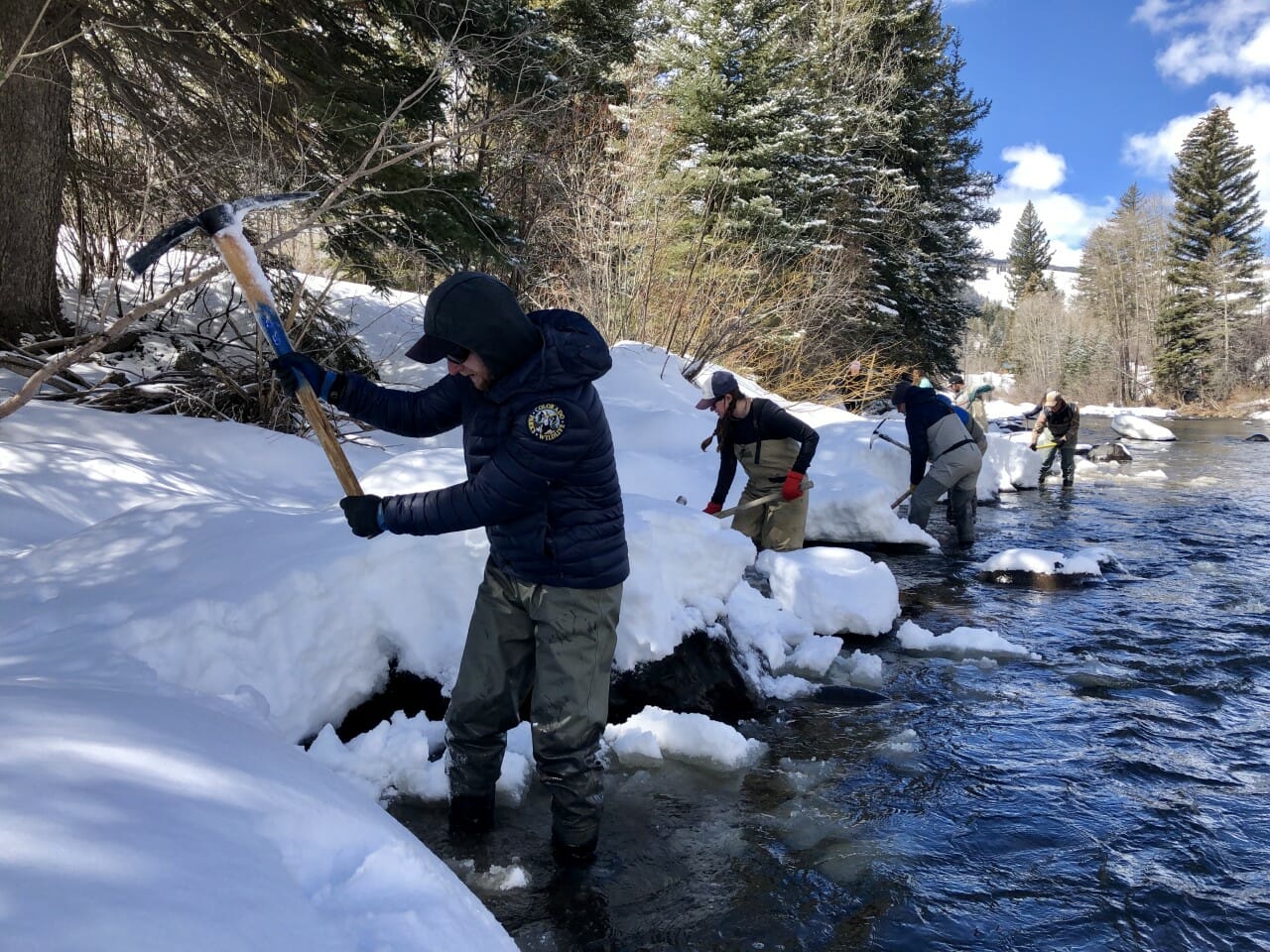Call me Kristoff, like the animated ice harvester of Arendelle best known for “riding across the fjord like a valiant, pungent reindeer king” to save the blustery day in the famous final scene of the fictitious film, “Frozen.”
The real-world “fjord” on this frosty 24-degree morning in the rustic but comparably quaint hamlet of Minturn, Colo., is actually the Eagle River, although its wintry banks have narrowed enough to form bridges of ice and snow in some spots, rigid cornices protruding above the current in others.
I’m standing thigh-deep in slush alongside Nick Noesen, president of TU’s Eagle Valley Chapter, and a handful of Colorado Parks and Wildlife employees and volunteers dedicating a Saturday morning to chopping ice in the name of trout research. But despite my own piercing aroma, I’m hardly the hero in this scene.
Like many Colorado mountain towns, Minturn is a former mining town, and it feels like an unusual hybrid of mining and fishing as I methodically swing the mattock and hack into some 18 inches of ice beneath an equal amount of snow. We’re mining for neither ice nor fish, however, but data.
Our job, on the heels of the snowiest winter this region has seen in a decade, is to break up the ice in order to prep a series of survey sites for fish “shocking” used to measure trout populations and impacts from an abandoned mine and Superfund site just upstream. We’re tediously chipping away the snow and ice so CPW’s aquatic biologists can reach the riverbanks beneath frozen ledges to find the fish.
Fish surveying is a fascinating exercise in and of itself. Agency staff and volunteers walk the riverbed side-by-side and nearby fish are collected by dipping lengthy electrodes in the water, which immobilizes them long enough to be scooped up in a net. Fish, as they say, are always biting on electricity.
But as spooky as wild trout are, they’re also always looking for places to hide from intruders wading into their homes, and an icy ledge is an ideal area to take cover.

“Brown trout love undercut banks, and that’s basically what these ice ledges are — a perfect undercut bank,” said Kendall Bakich, the regional aquatic biologist who heads up the annual Eagle River survey. “When they see us coming, they’ll duck under the ledges for cover and we may not get an accurate fish count.”
The Eagle boasts the longest consistent fishery monitoring data set in Bakich’s central mountain region (which also includes the Roaring Fork, Fryingpan, Crystal and Colorado rivers, among others), collected annually around April 1 over a span of more than 30 years. So even in a banner snow year such as this, every effort is made to keep the streak alive in order to monitor the impacts from the Belden Mine upstream. That means a day of cold, sweaty labor before her work can actually get underway, the less glamorous side of what’s not really a very glamorous job to begin with.
But it certainly is important to folks like you and me. The efforts of Bakich and her team at CPW give us insight into where the best fishing is, where it needs improvement, what the trends are, potential problems and, of course, solutions. On the Eagle, for instance, we know that the fish health and populations have improved considerably since heavy metal contamination from the mine peaked in the early ’90s, and have stabilized at less than perfect levels in recent years.
While the fishery still has room for improvement, it’s no longer considered cost effective to continue tweaking the system until the technology for mine cleanup improves and becomes less expensive. And when that happens, the data will be there to show that further improvement is warranted.
Meanwhile we discover that the Eagle is trending upward at the moment. Where overall trout numbers had been on the wane in recent years, apparently the low flows of the past few years have given younger fish a better chance of survival. Sculpin too.
“The data we collect has documented improvements in the fishery in relation to a major mining pollution source, as well as changes over time with a warming climate, increasing population and transforming landscape in the middle Eagle River corridor,” Bakich says in her finest science-speak. “This year, we documented a notable number of YOY (young-of-the-year) rainbow trout above the confluence with Gore Creek and a remarkable number of fish downstream.”
Since Gore Creek significantly dilutes the mine-impacted waters of the upper Eagle River near Minturn, the discovery of several fragile young rainbows is music to muffled ears and motivation to keep chiseling away at this ongoing restoration project. It’s comforting to know that the hardworking staff of Colorado Parks and Wildlife is out there doing this difficult work and that assistance from the local TU chapter pays direct dividends to their research efforts.
Besides, once I put down my pickaxe and shed my heavy coat, that Orvis 5-weight is going to feel as light as the feather it’s casting.
Scott Willoughby is TU’s sportsmen’s outreach coordinator for Colorado. He lives and works near Vail.



